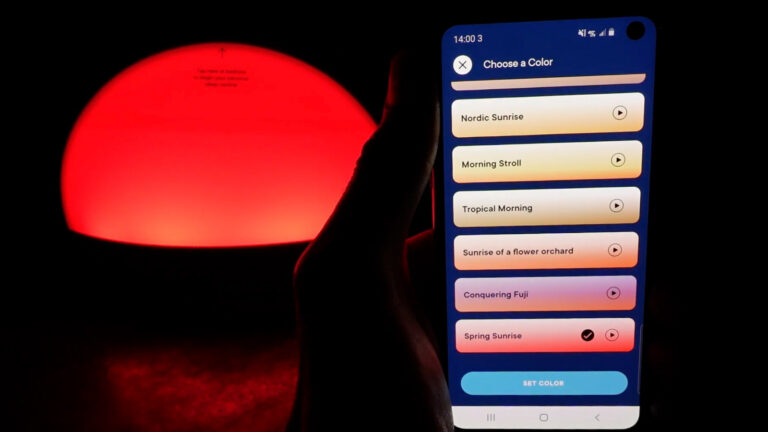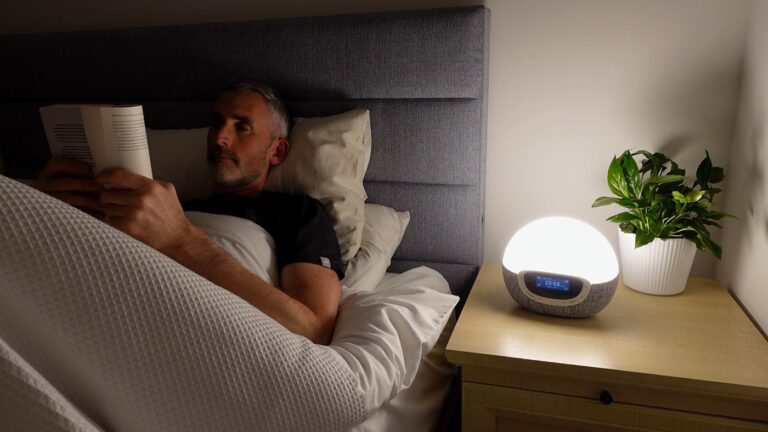Disclosure: My website is reader supported. If you decide to buy something after clicking a link, I may earn a commission, at no extra cost to you. Learn more.
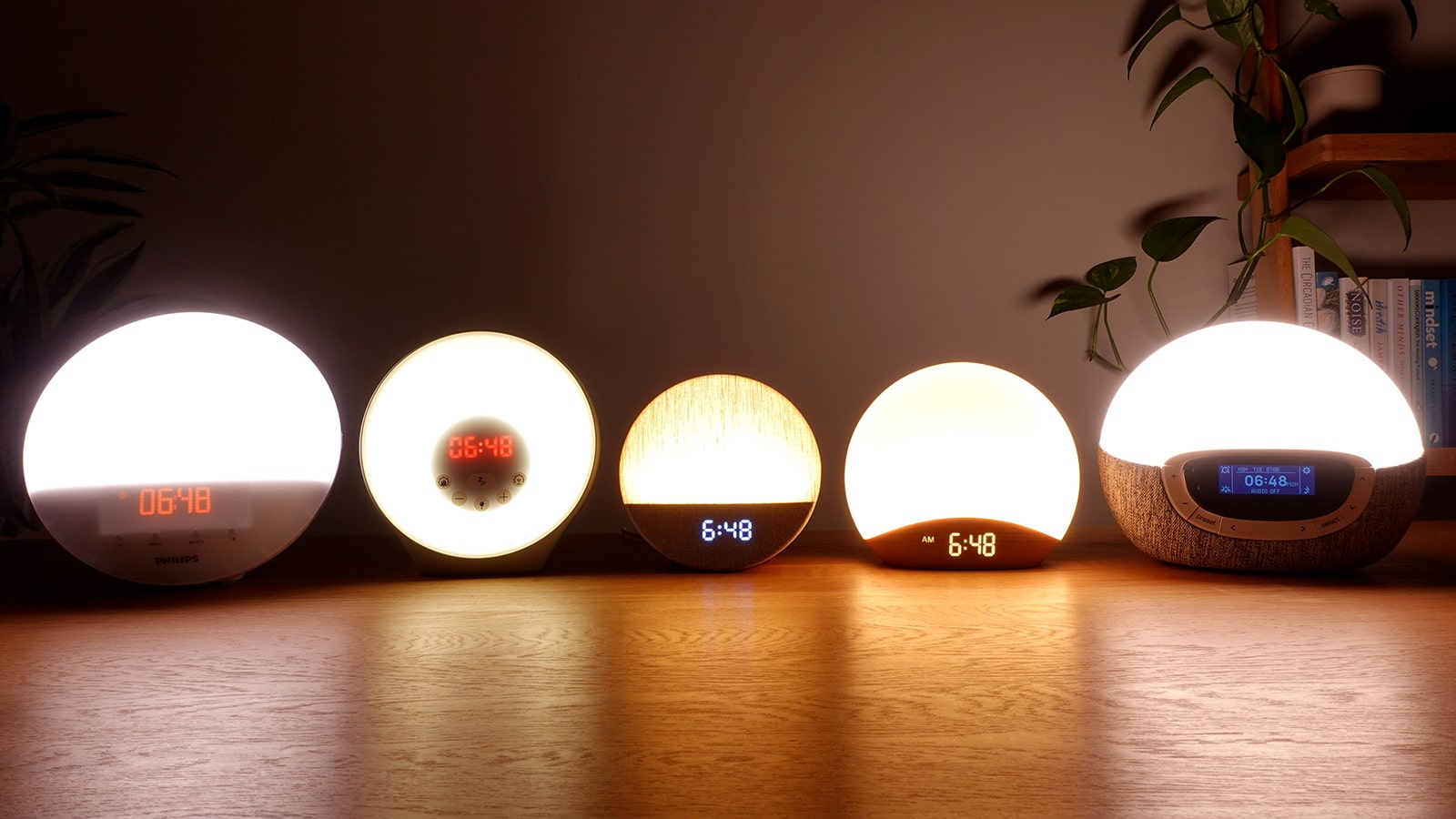
In the photo above, you can see the five sunrise alarm clocks I’ll be discussing in this article, all of which I bought and tested for many nights.
Contents
The core concept of a sunrise alarm clock (also sometimes called a wake-up light) is that it makes waking up in the morning a more pleasant experience. No more loud alarm tones that rudely remind you that your dream world wasn’t real and you have to go to work, again.
Sure, you still have to get up and go about your business, but hopefully the transition from blissful sleep to the daily grind will be a bit more subtle.
I always have a wake-up light in my bedroom; experience has taught me that I feel better waking up with light rather than just loud noise in total darkness. I also love falling asleep as the light dims from white to deep orange or red.
I’ve tested and used a wide range over the years, and in this article I’ll be sharing my current top picks to help you choose one. None of them require another device, app, or subscription to control them or access any features.
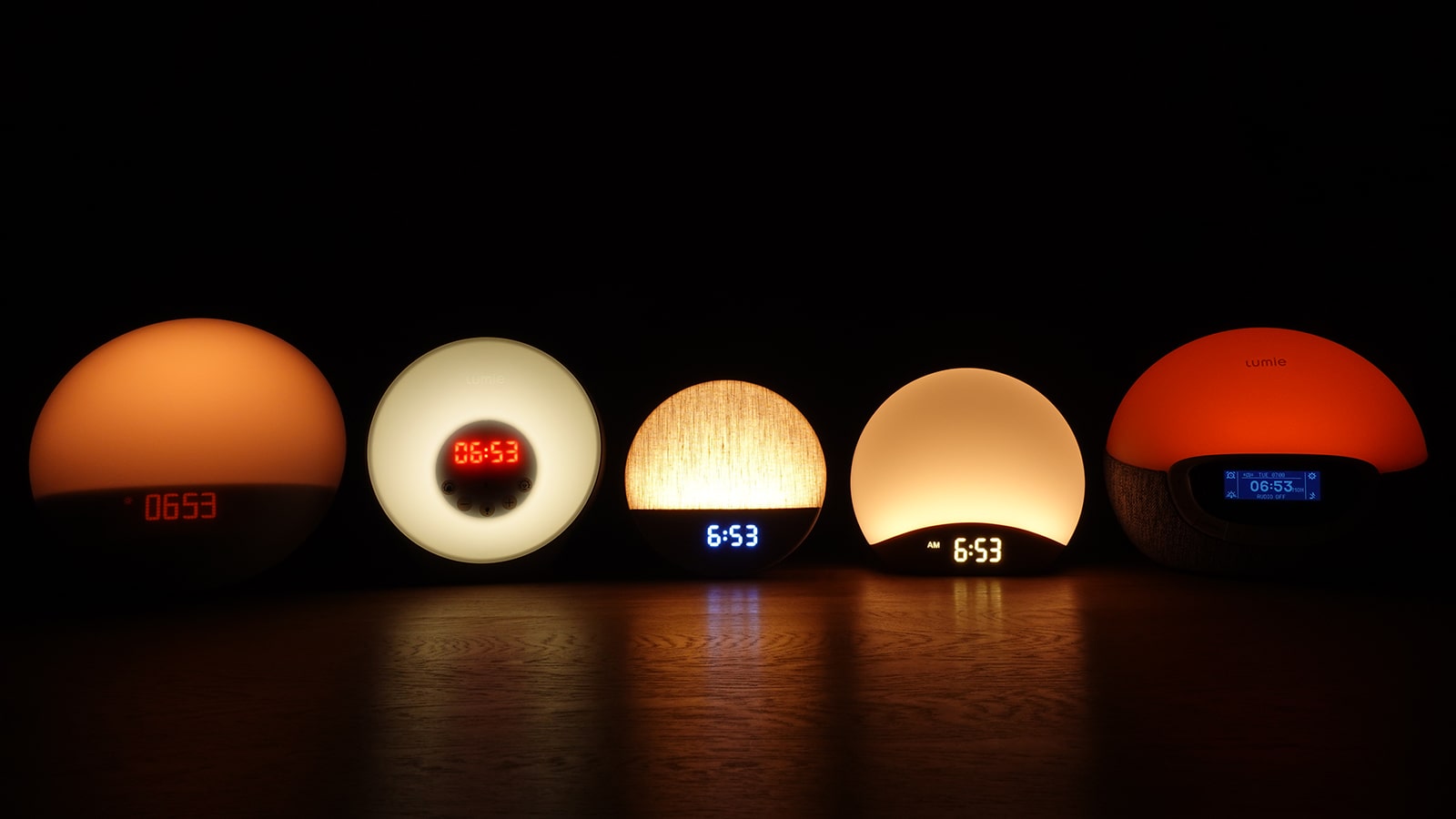
In the photo above, you can see how the mixed LEDs of the Lumie Bodyclock Shine 300 and Philips Smartsleep fade from their bright white to orange and red. The other three only dim on one color, which is the most important difference between them.
Overview
Philips SmartSleep
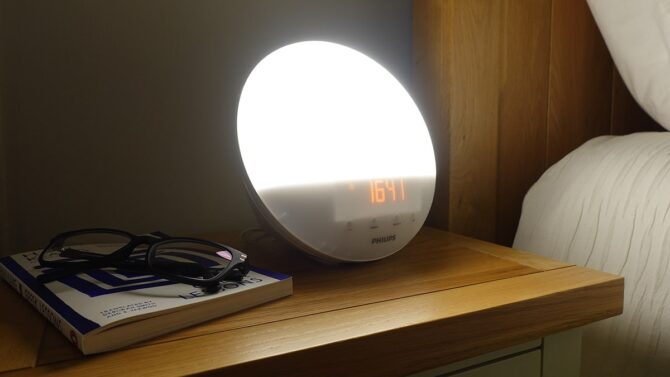
Key features: Sunrise, sunset, FM radio, alarm tones, two programmable alarm times, reading light, dimmable clock.
Price: $$$
The Philips SmartSleep is currently my top pick because the sunset and sunrise effect are beautiful and realistic, and it has noticeably better audio quality than the rest.
With 20 brightness settings, and a very bright maximum, it does the main job of waking you up gently very effectively. The dimmest colours are warm deep oranges that fade in slowly, and are also lovely to fall asleep to.
It has an FM radio or relaxing sounds to wake up to. There aren’t many sounds, but the birds + music is our personal favourite of all five devices.
The main issues to consider are the slightly complicated buttons to program it and the larger size.
Lumie Bodyclock Shine 300
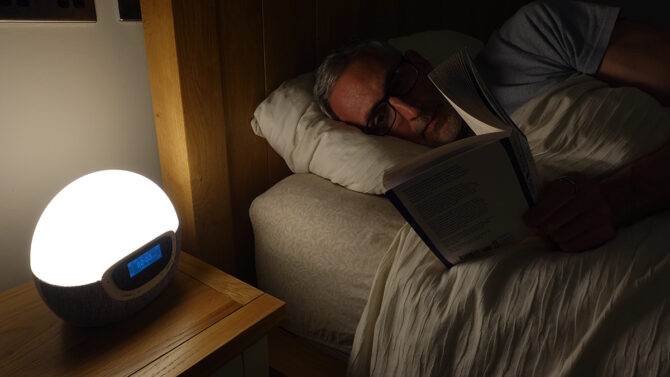
Key features: Sunrise, sunset, FM radio, alarm tones, daily alarms, reading light, night light, dimmable clock.
Price: $$$
The Lumie is an excellent choice if you want the most realistic fade from red to white in a sunrise alarm clock. The dimmest settings are gorgeous deep reds, which then slowly transition through orange and yellow to a bright white.
The maximum setting is the brightest of all five wake-up lights, so it’s very effective in the morning. It also works well as a reading light or nightlight.
The FM radio and 15 alarm sounds give plenty of options to wake up to, and you can program an alarm for each day of the week independently.
The main downside is the complicated sequences of buttons needed to program it.
Lumie Sunrise Alarm
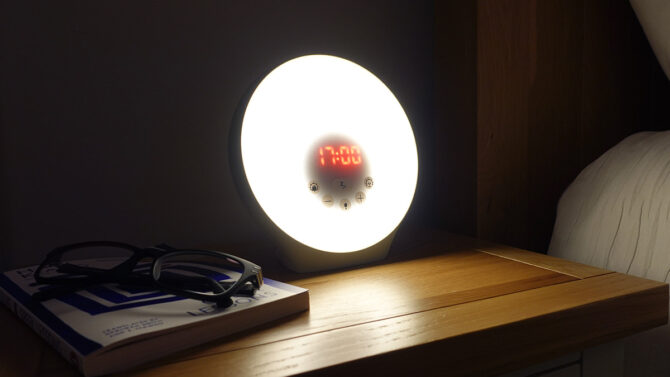
Key features: Sunrise, auto-off timer but no sunset, 6 extra colours, alarm tones, one alarm, reading light, night light, dimmable clock.
Price: $$
The Lumie Sunrise Alarm is much lower priced than the Bodyclock Shine 300, but also has less features.
While it does have an additional six non-fading colours, the main sunrise effect only has 10 brightness levels. The dimmest are warm white rather than deep orange or red.
There isn’t a sunset fading effect either, with just a basic auto-off timer.
The speaker quality is quite basic, but the bird alarm tones are pleasant on quieter volume settings. It’s a simpler device overall, but does take up less space to make up for that.
Dreamegg Sunrise 1

Key features: Sunrise, auto-off timer but no sunset, 9 dimmable colours, 6 alarm tones, 29 white noise sounds, night light, reading light, one daily alarm, dimmable clock.
Price: $$$
The Dreamegg Sunrise 1 is a cute little wake-up light that doubles as a white noise machine, with 29 sounds ranging from brown noise to birds and lullabies.
There are nine colours to choose from, all of which can be dimmed and used for the sunrise, or left on one brightness setting as a reading light or nightlight.
It doesn’t fade through a range of colours like the Philips or Bodyclock and there’s only an auto-off timer rather than a fading sunset. There’s only one daily alarm option, but it’s much easier to operate.
Reacher Sunrise Alarm Clock
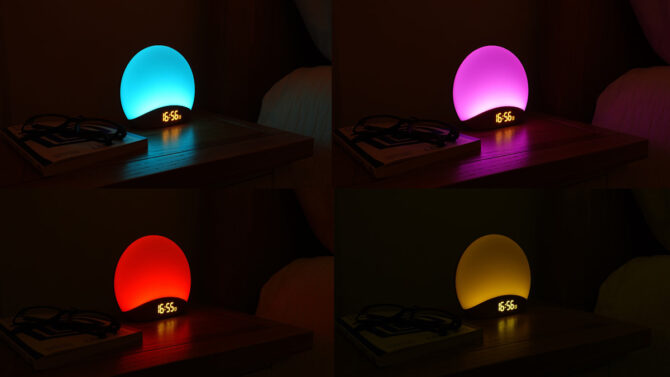
Key features: Sunrise, auto-off timer but no sunset, 8 dimmable colours, 3 alarm tones, 26 white noise sounds, night light, reading light, one daily alarm, dimmable clock.
Price: $$
The Reacher is a budget-friendly wake-up light that’s similar to the Dreamegg in several ways. It has eight light colours to choose from, all of which can be dimmed.
The sunrise works with any of those colours, and there are three alarm sounds and 26 ‘any time’ sounds.
The main downsides are the poor speaker quality and limited alarm tones, which don’t sound good at loud volume levels. And there’s only a basic auto-off timer rather than a fading sunset.
The overall design is basic compared the other four, so this is one that will suit those on a budget who prefer bold colours rather than a more subtle sunrise or sunset effect.
Comparison tables
Table 1: ratings
In the table below, I’ve given the wake-up lights a score out of 10 in some key areas: the quality of the sunrise/sunset effect, the maximum brightness, ease of use, and sound quality.
The blue links will take you to the relevant Amazon listing.
| Device | Sunrise effect | Max brightness | Ease of use | Audio quality |
|---|---|---|---|---|
| Philips SmartSleep | 10 | 9 | 7 | 9 |
| Lumie Bodyclock Shine 300 | 10 | 10 | 6 | 7 |
| Lumie Sunrise Alarm | 7 | 7 | 8 | 5 |
| Dreamegg Sunrise 1 | 6 | 6 | 9 | 8 |
| Reacher Sunrise Alarm | 5 | 5 | 8 | 4 |
Notes on the points I considered when scoring them:
Testing time: I used the BodyClock Shine 300 for over two years, the Philips for the last three months, and the other three I spent at least two weeks using them every night.
Sunrise effect: how well it fades in or out, if the light settings jump noticeably, and how warm and gentle the lowest light settings are.
Max brightness: how bright it can get as a reading light, or for waking you up.
Ease of use: how easy it is to program. I also imagined how intuitive it would be if you lost the manual!
Sound quality: the speaker quality for the radio and/or wake up sounds, and how repetitive the sounds are.
Table 2: Light features
In the next table, you can compare the main light features I look out for when using wake-up lights.
| Device | Sunrise / sunset or auto-off timer duration (mins) | Brightness settings | Colours |
|---|---|---|---|
| Philips SmartSleep | Sunrise 20-40 Sunset 5-60 | 20 | Orange to white fade |
| Lumie Bodyclock Shine 300 | Sunrise 15-90 Sunset 15-90 | 20 | Red to white fade |
| Lumie Sunrise Alarm | Sunrise 30 Sunset 30 | 10 | White fade + 6 colours |
| Dreamegg Sunrise 1 | Sunrise 5-60 Auto-off 5-180 | Many on a slider | 9 dimmable colours |
| Reacher Sunrise Alarm | Sunrise 5-60 Auto-off 5-180 | Many on a slider | 8 dimmable colours |
In the photo below, you can see how the Lumie Sunrise Alarm, Dreamegg Sunrise 1, and Reacher have the option of different colours. The Lumie Bodyclock Shine 300 and Philips SmartSleep focus only on the sunrise colours of red, orange, yellow, and white.
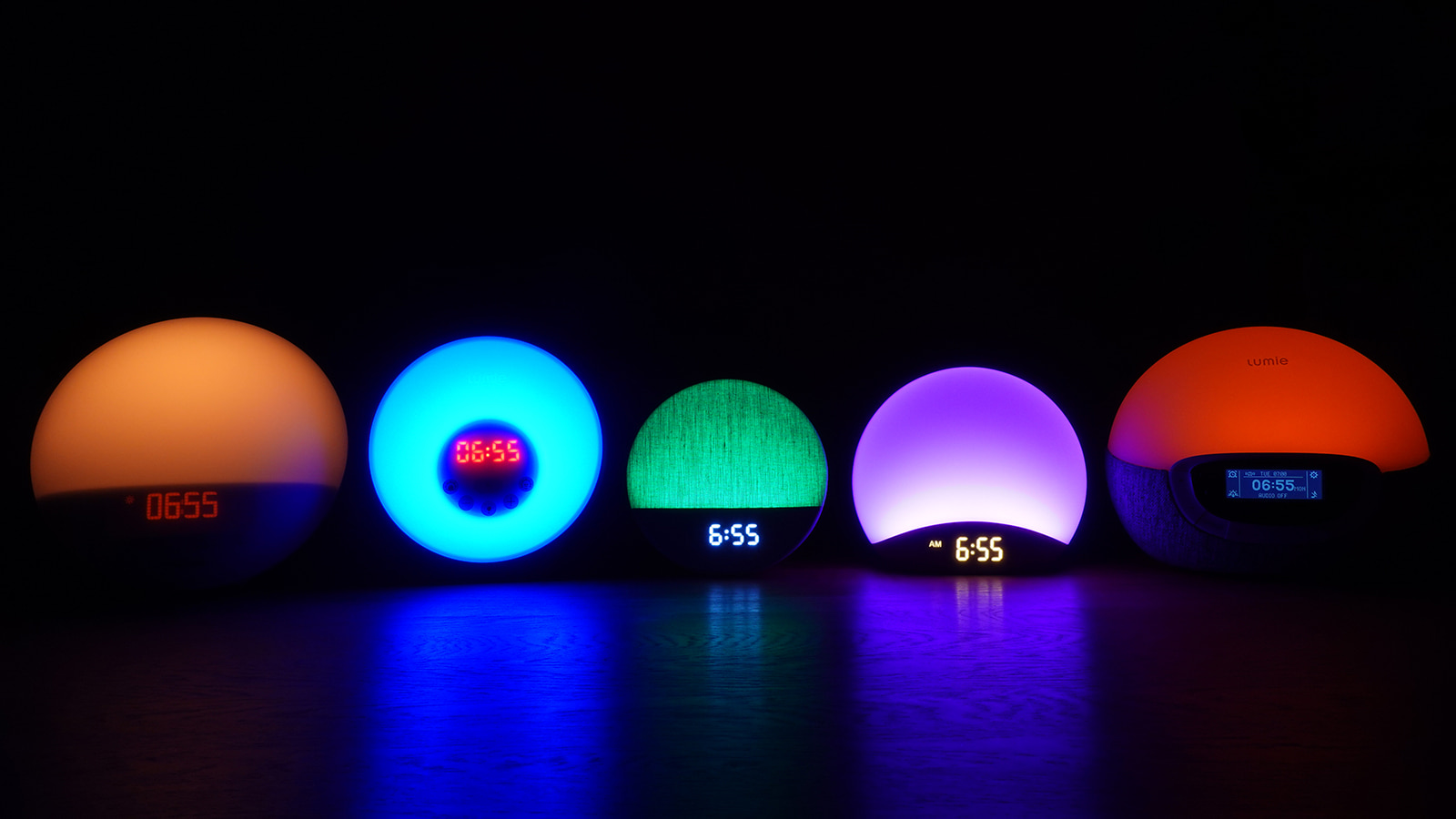
Table 3: Size and audio features
In the next table, you can compare the size and main audio features.
| Device | Size | Radio | Alarm sounds |
|---|---|---|---|
| Philips SmartSleep | Large | ✔ | 5 or radio |
| Lumie Bodyclock Shine 300 | Large | ✔ | 15 or radio |
| Lumie Sunrise Alarm | Medium | X | 6 |
| Dreamegg Sunrise 1 | Small | X | 6 alarm sounds 29 ‘any time’ sounds |
| Reacher Sunrise Alarm | Small | X | 3 alarm sounds 26 ‘any time’ sounds |
Video review
In the video below, I discuss all five sunrise alarm clocks in depth. I also filmed each sunrise over 20 minutes and sped it up so you can see the dimming and/or color transition. I demonstrate some of the alarm tones as well so you can have a listen.
I filmed it in March 2025 after testing them out over the winter of 2024 into this year.
Video transcript & full review
Please note that I made a few edits to the transcript so it’s clearer to read. I’ve also taken additional photos of the sunrise alarm clocks, so there’s something new if you watched the video as well as reading this.
Introduction
It’s 6:00 in the morning. It’s pitch black outside. And your alarm suddenly starts shouting at you that it’s time to wake up again.
Why does that feel so bad?
I find the process of waking up feels a lot better and more natural when there’s light slowly filling the room. So if you do have to wake up before dawn, a sunrise alarm clock, also known as a wake-up light, is a more gentle way to wake up than a loud alarm tone.
I’ve used one myself for years, specifically the Lumie Bodyclock Shine 300. But I recently bought a few new ones as I was curious to find out if there was any that would be better than the Lumie.
Before I go through each of them in detail, there are a few key points to make.
Why I chose these ones
Firstly, why I chose these ones. For this video, I decided to focus on some mid-range options because the cheapest ones can be pretty bad quality, and the premium ones can be very expensive or have a subscription to access extra features. And in the past, I’ve found that you can get a good one for between 50 and 150 US dollars or British pounds.
Do you even need one?
Secondly, if you’re watching this video and thinking to yourself, “Well, I’m fine with my phone alarm,” or “I’ve got smart lighting that does the same thing,” or perhaps you always wake up late anyway, fantastic—stick with what works.
You probably don’t need one of these, and you can save yourself some money.
Features all 5 have
When testing them out, I found that there are some things that they’ve all got in common. So let’s run through those first, and then it’ll save some time, and I won’t need to repeat it in each section.
- They all have a sunrise feature with light that fades in, though the quality varies enormously.
- All the LED clock displays can be turned off completely.
- You can choose between a 12 and 24 hour clock.
- if you want an alarm tone, it will come on at your chosen alarm time, but the light always fades in before that.
- They all have a snooze feature.
- They all have a memory for the clock when unplugged, though the length of time varies.
- They all come with a power adapter and need to be plugged in to work.
So, with that said, let’s take a close look at each one.
1. Philips SmartSleep
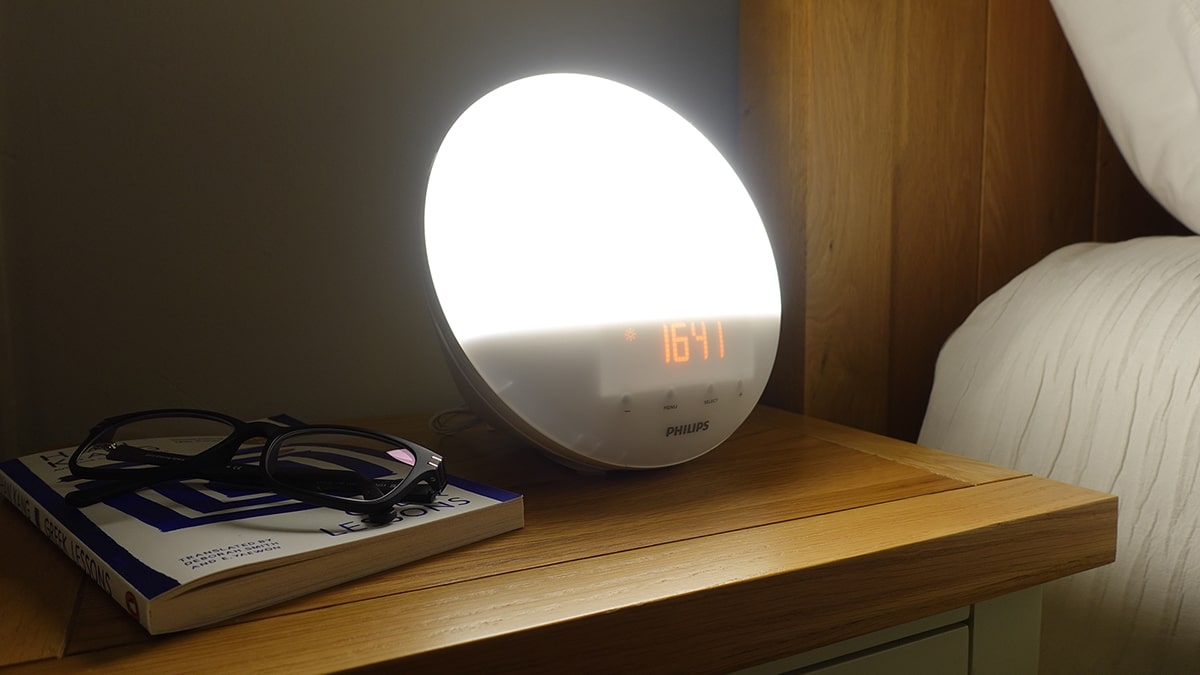
In the photo above, I have the Philips SmartSleep on my bedside table. The clock has four brightness settings or can be switched off completely.
After testing all five, the Philips SmartSleep is the one that my partner and I have decided to keep using for a while. So yes, my old Lumie has finally met its match. However, those two are both fantastic wake-up lights, and there are some points that the Lumie does better.
But the reason we decided to hang on to this one for now is that the buttons were a little bit easier to use, and it also has the best alarm tones.
Let’s start by taking a look at the sunrise, which I filmed over 20 minutes and have sped up several thousand percent (this is at 2:24 in the video if you’d like to watch it).
The sunrise effect begins with a deep orange-red that fades in gently. It slowly transitions through amber hues and finishes with very bright white. The light usually wakes me up before the alarm tone kicks in, which I’m fine with as it’s a more gentle wake-up.
I love the slow fade from red to orange and white of the LEDs. It feels much more natural than the basic one colour dimming of some devices. For me, this is essentially what makes a good wake-up light. The focus is on a realistic sunrise and sunset effect rather than packing in a range of colors.
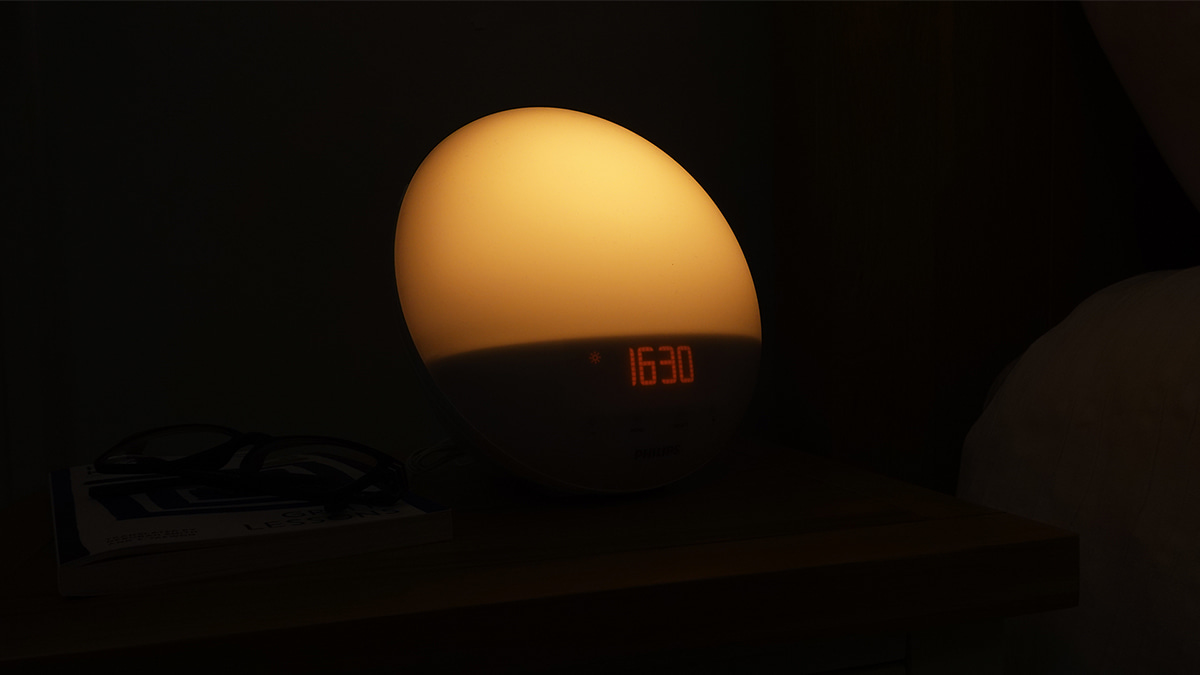
In the photo above, you can see one of the dimmest light settings. It may look more or less orange depending on the device you’re reading this article on. The main point to consider is that the dimmest settings are warm and soft.
I also like how you can choose between 20 and 40 minutes for a shorter or longer sunrise, and you can set up two alarm profiles with a different time on each.
You do need to remember to turn the alarm on each night, though, or nothing will happen in the morning.
When the sunrise finishes, you can choose to have one of five alarm tones or the FM radio come on. We love the music with birds option, which is very pleasant to wake up to. It’s a bit like waking up in the safe zone of a video game. Maybe World of Sleepcraft?
The speaker quality is fine as an alarm, and the maximum volume just about cuts through my earplugs if I’m using them.
The Philips SmartSleep is more than bright enough to use as a reading light, which is great if you don’t want a separate reading light on your bedside table.
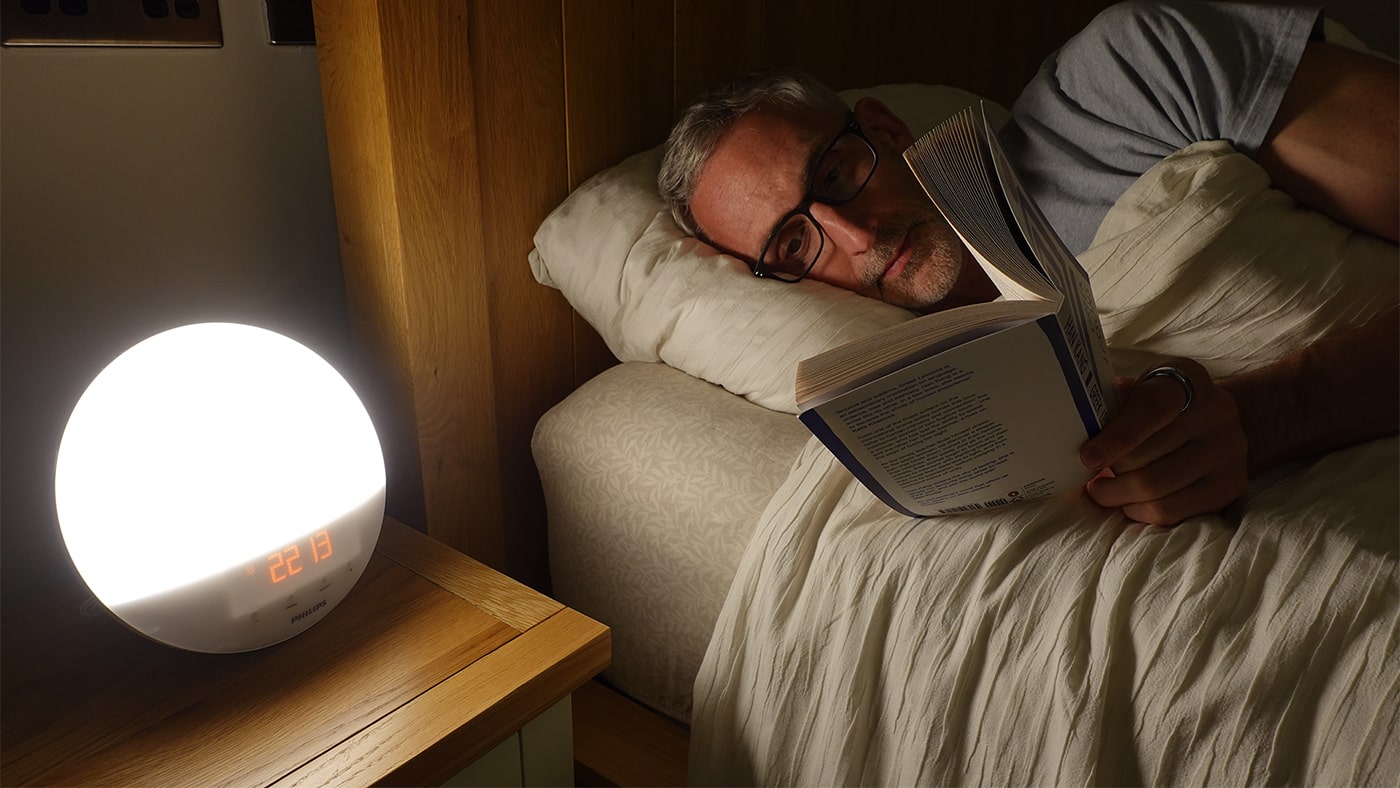
In the photo above, I’m using the Philips SmartSleep as a reading light. With my vision, the Philips and two Lumie models were the most comfortable to read with.
The sunset effect of the Philips is similar to the sunrise but in reverse. Note that only the Philips and Lumie Bodyclock Shine 300 have a fading sunset, while the three I’ll look at later only have a basic auto-off. I find the slow sunset is very soporific and helps me fall asleep, while the slow sunrise helps me wake up gently. And that’s exactly what a sunrise alarm clock is meant to do.
My main criticisms are around the size and the buttons. Even though the buttons are easier to use than the Lumie, they still take some getting used to. And while I like how the little lights glow when your finger is near the buttons, having buttons on the front and the top is a bit confusing.
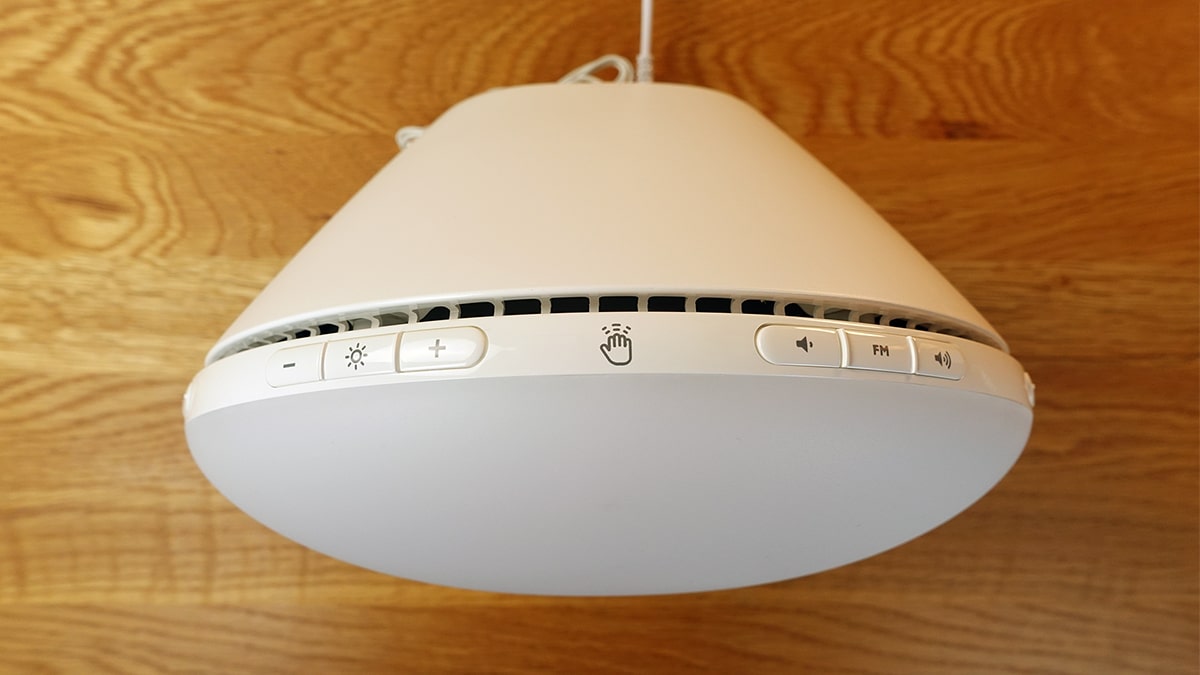
In the photo above, you can see the top bank of buttons. Unlike setting the timers, it’s at least very easy to turn the light and radio on or off.
It is the largest of the five lights, so if you have a tiny bedside table, you might need to place it somewhere else.
As for the price, I bought the HF 3519 SmartSleep for £98.99 in the UK, and the similar HF 3520 currently costs just under $110 in the US.
Philips does use confusing model names with the HF codes, and they may have different models available by the time you watch this video, so it’s always worth checking the different features between the current models.
2. Lumie Bodyclock Shine 300
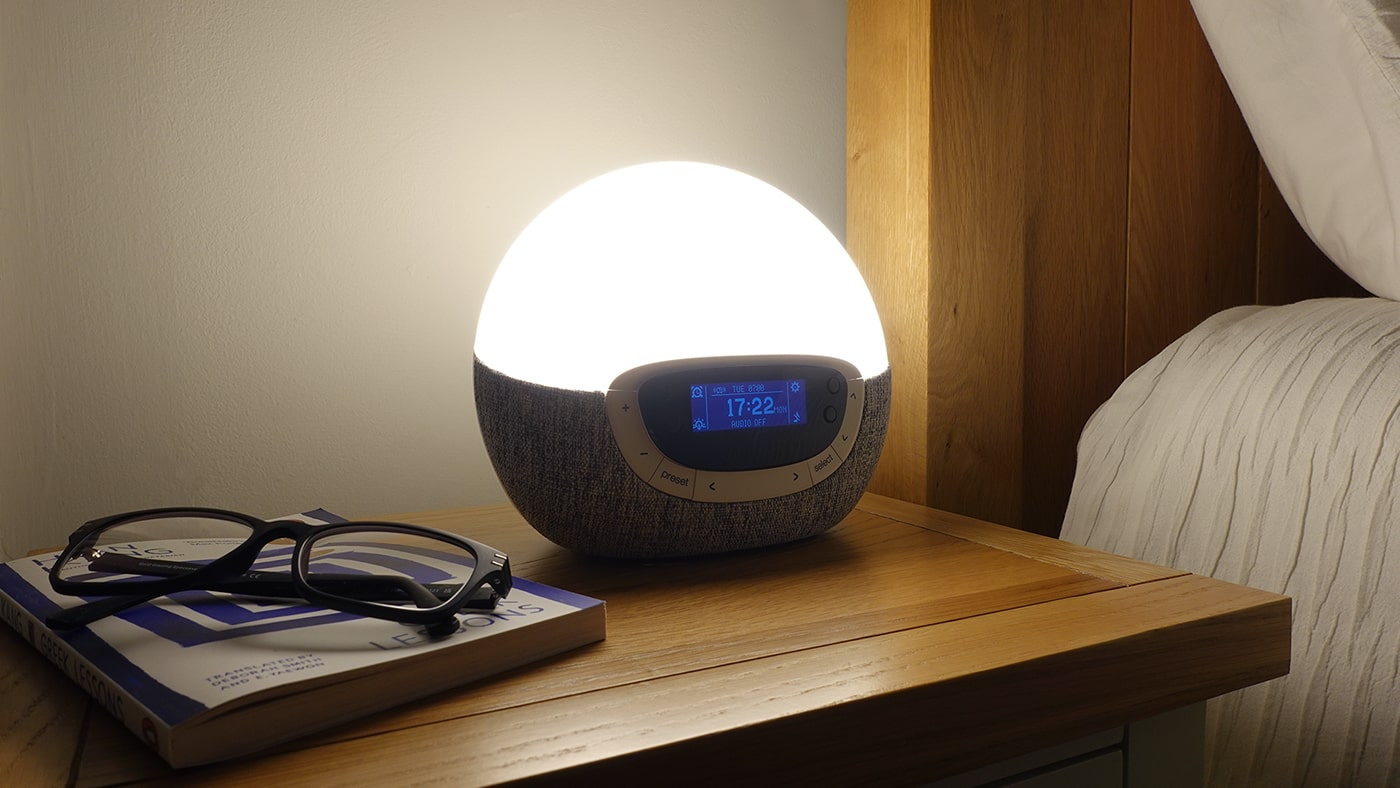
In the photo above, you can see the Lumie is very bright. This is on setting 16 out of 20 as the maximum was too much for my little camera!
As I mentioned earlier, I used the Lumie Bodyclock Shine 300 for a long time, and even though I’ve switched to the Philips recently, I still think this is a superb wake-up light. And there are a couple of situations where I think it could be a better choice.
Starting with those: it’s a little bit smaller than the Philips, so if space is tight on your bedside table, it could be a better choice.
Secondly, while the Philips has two programmable alarm times, you can program a separate alarm for each day of the week with the Lumie. And if you do program them in, you don’t have to remember to turn the alarm on at night.
Aside from that, there’s one standout feature that the Lumie and Philips have in common: the realistic sunset and sunrise simulation. Here’s a 20-minute sunrise effect sped up again so you can see the color transition (this is at 5:12 in the video if you’d like to see it in action).
What I loved about the Lumie all these years is the gorgeous spectrum of colors that the mixed LEDs fade in or out with. It runs from a very deep red up to a bright, warm white. I actually prefer the dimmer settings of the Lumie to the Philips. The final reds are even deeper.
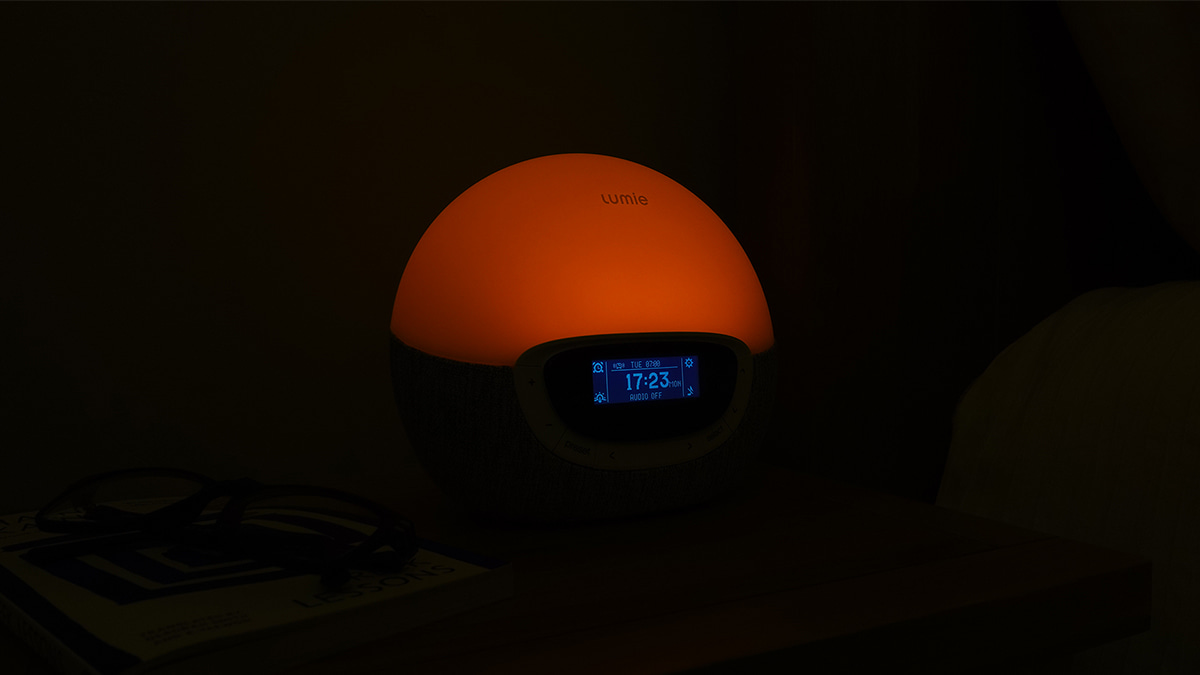
In the photo above, you can see one of the deepest colours of the Lumie. This appears at the start of the sunrise or end of the sunset. You can also set it as a nightlight.
You can select a sunrise or sunset length from 15 to 90 minutes, and I like how you can further customize it by selecting a final brightness level for the sunrise or fading the sunset to a night light rather than off.
The Bodyclock is the brightest of all five wake-up lights I tested, so if you need plenty of light to read by, it might be the best choice.
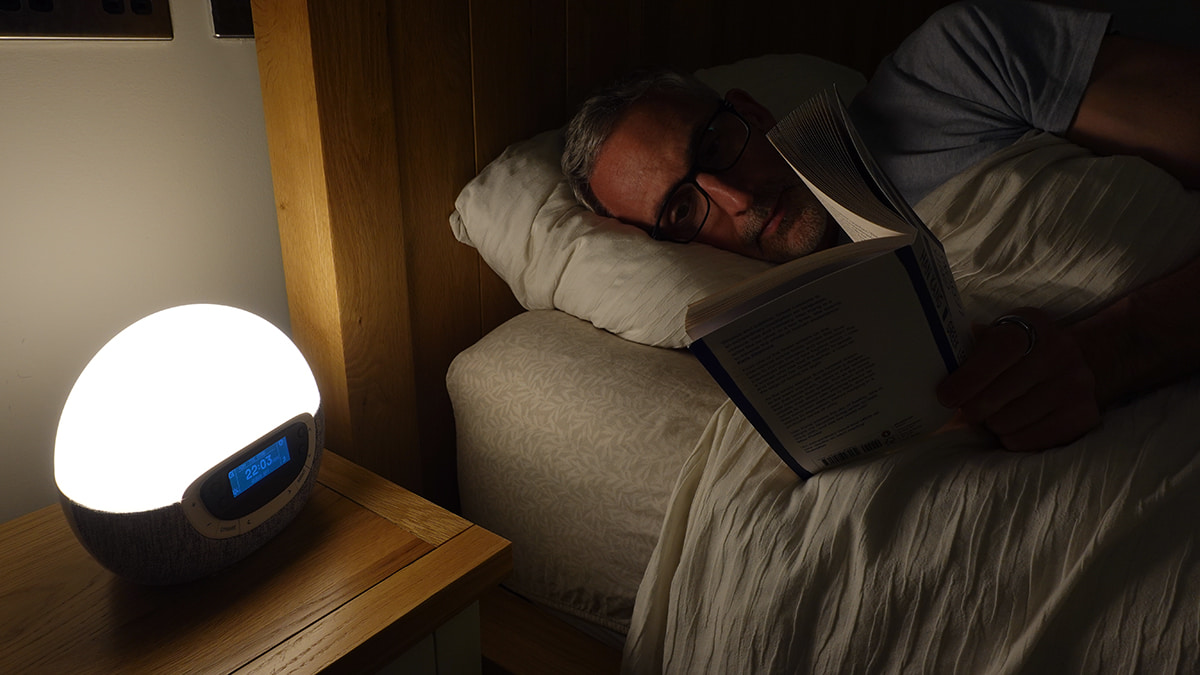
In the photo above, I’m using the Lumie as a reading light. It’s a lovely, warm white to read to and you can keep it on one brightness setting for as long as you like. This isn’t even on the brightest setting, as it’s so bright I can turn it down when reading.
If you want alarm sounds at the end of the sunrise, you can choose between the FM radio or 15 alarm tones.
Some tones are a bit silly, like the goats, but others are really good, such as the three different bird tones and the waves. They’re also very relaxing to listen to when falling asleep.
The speaker is relatively quiet, though, which is common with sunrise alarm clocks. But it’s fine for morning use, and the combination of light and audio still woke me up effectively on the many nights I used it.
My main criticism is the buttons. This is by far the most complicated wake-up light to program. Even after a year, I still found I’d pressed the wrong sequence of buttons sometimes. I can understand that it’s trickier because there are so many options, but it does require a bit of patience to use when you first get it.
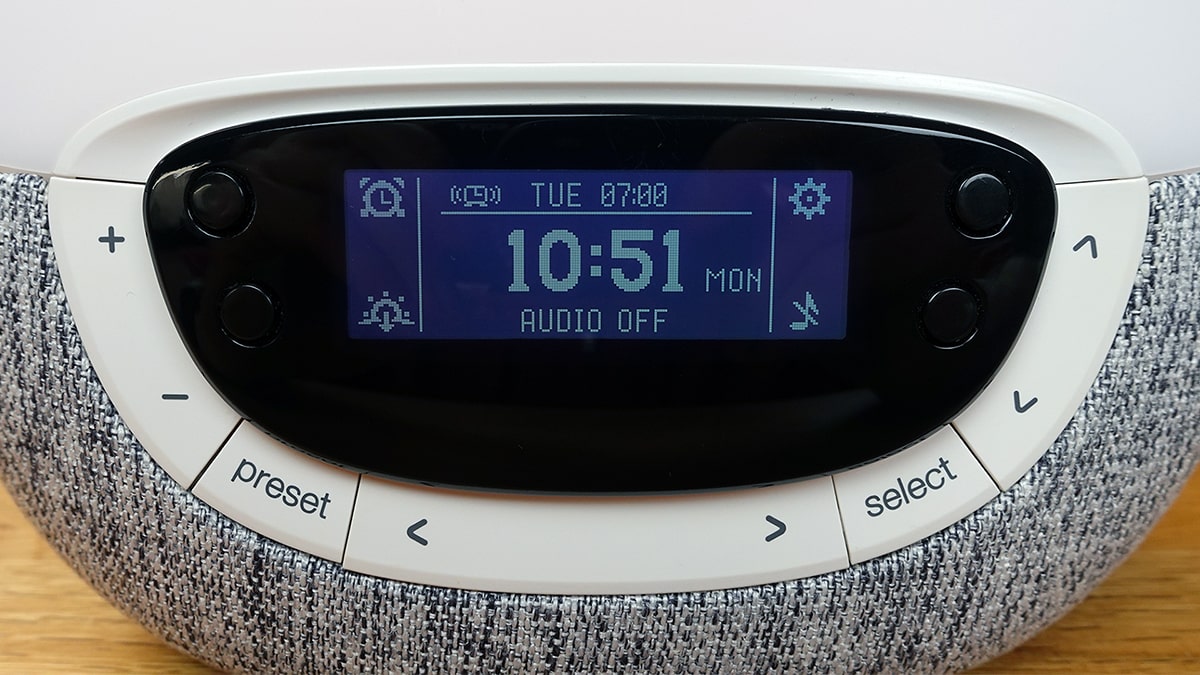
In the photo above, you can see the buttons and clock of the Lumie Bodyclock shine 300. You may be able to work out the settings without a manual, but it will require some patience.
Secondly, even though the digital display is useful as you can see the current settings, it has a slightly dated look.
A final potential issue for those on a tight budget could be the price. It typically costs over $150 in the US and just under £150 in the UK. There are more expensive Lumie models which might have a DAB radio and a more modern design, but there are also some lower-cost Lumies, such as the one coming up next.
Read my full Lumie Bodyclock Shine 300 review.
3. Lumie Sunrise Alarm

In the photo above, you can see that the Lumie Sunrise Alarm doesn’t take up as much space on my bedside table as the previous two devices. I also quite like the circular light effect with the buttons in the middle.
The Lumie Sunrise Alarm is one of the better lower cost wake-up lights I’ve tested. It’s often available at a third of the price of the Lumie Bodyclock Shine 300. However, it’s much less customizable in ways that could be a deal-breaker for some people.
One trick it does have up its sleeve is the option to switch between six LED light colors, as well as the sunrise white. There’s green, red, blue, pink, orange, and light blue. I wouldn’t use them myself, but fans of Barbie or Avatar might like the colors!
They can’t be dimmed, though, so they’re best used as a nightlight or a mood light. The sunrise and sunset simulation only work with the white light, and there’s only a 30-minute duration. This is much less flexible than the timer length of the other lights.
Here it is sped up so you can see the transition. There are 10 brightness settings compared to the 20 of the previous two lights, so the jump between levels felt much more noticeable. It also doesn’t start or finish with a deep red or orange, just a warmer, soft white (this is at 7:47 in the video if you’d like to watch it).
After using the Bodyclock and Philips, I found I really missed the more realistic sunrise and sunset. There’s just one daily alarm you can set with a choice of six alarm tones.
The birds are quite pleasant and definitely woke me up on louder volume settings. However, the speaker sounds too tinny at those volume levels, so I had to keep it quieter.
As a reading light, even the brightest setting was just a bit too dim for my liking. It’s okay for a short while, and it’s probably fine for younger eyes, but if you need bright light to read, it could be an issue.
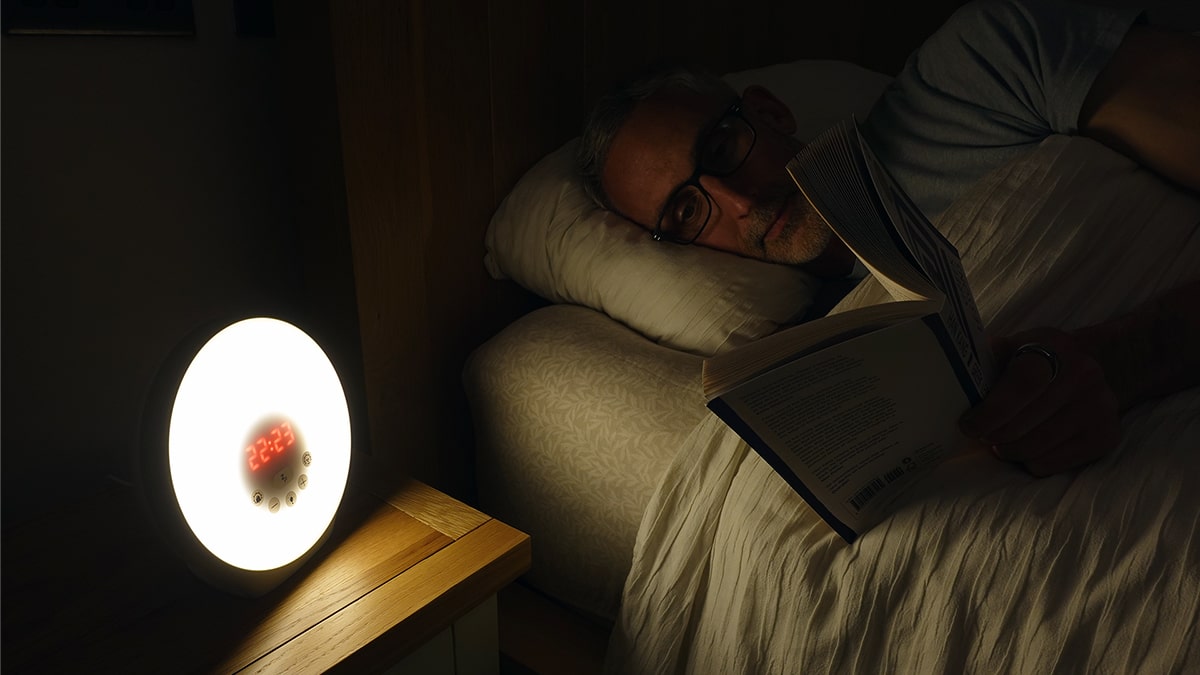
In the photo above, you can see that the Lumie Sunrise Alarm might not be bright enough for everyone to use as a reading light. I found the previous two devices more comfortable, especially if I’m tired and my book has a small font size.
Like other Lumie models I’ve used, the buttons take some getting used to. To be fair, though, I’m yet to find a sunrise alarm clock that’s very simple to program. It seems to go with the territory.
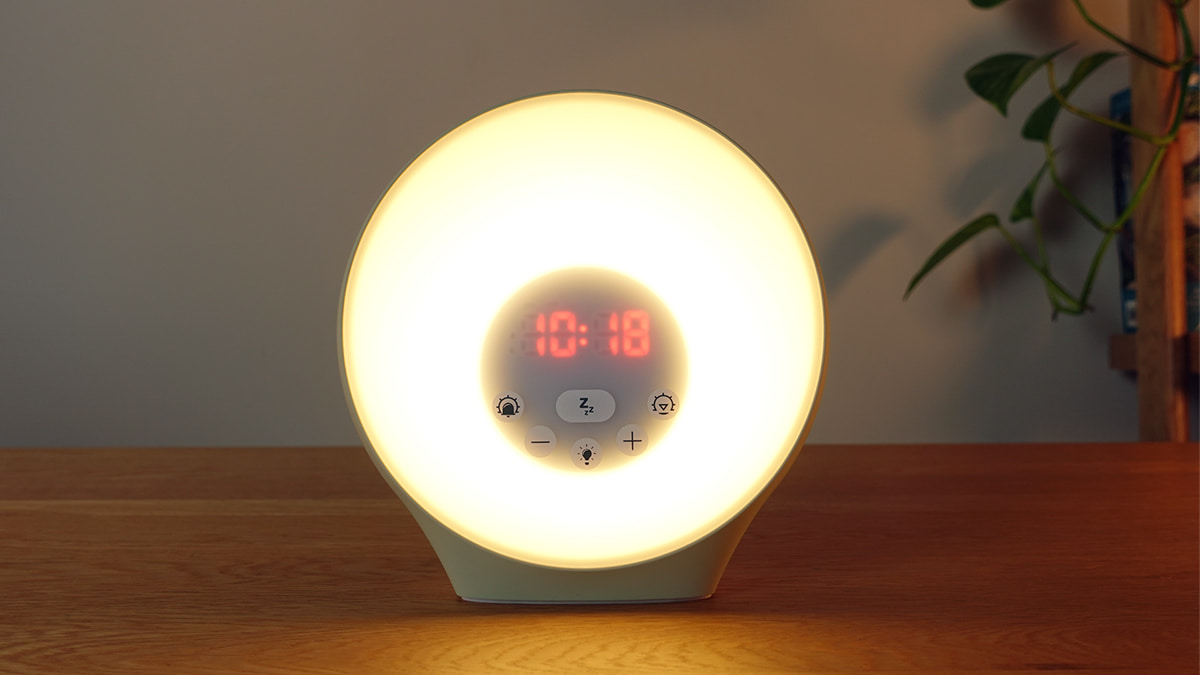
In the photo above, you can see the front buttons. There are five more on the top, so 11 buttons in total to change the settings.
It usually costs just under $50 in the US and just under £50 in the UK, though it’s sometimes unavailable in the US. But this does make it much more affordable than higher end Lumie, Philips, or Hatch wake-up lights, for example.
Overall, the sunrise and sunset effects are much more basic than higher end wake-up lights, and the fixed 30-minute duration isn’t ideal. Still, if you’re on a tighter budget and you just want a light that does the basics of fading in before your alarm time, it’s worth considering.
4. Dreamegg Sunrise 1
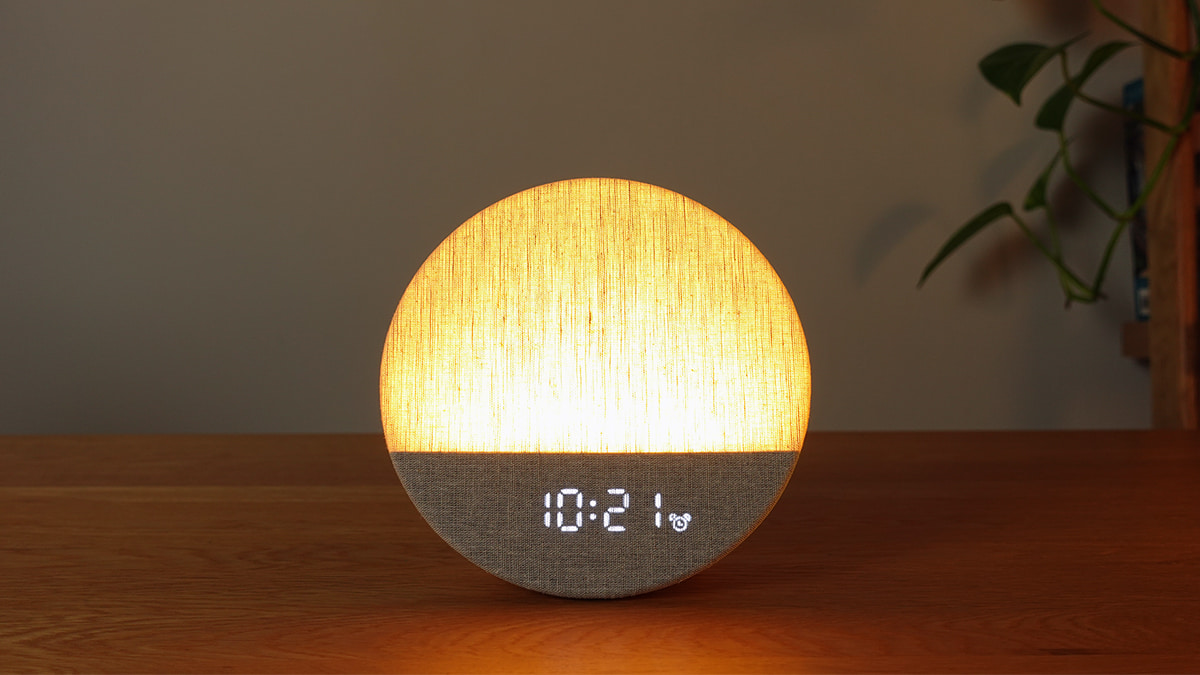
In the photo above, you can see the interesting pattern created by the light shining through the fabric on the front of the Dreamegg. It’s a cute little wake-up light that doesn’t take up much space.
Dreamegg are arguably better known for white noise machines, so it didn’t surprise me that the Dreamegg Sunrise 1 has some similar sounds to the Dreamegg D3 Pro white noise machine.
They also seem to have used a decent speaker, which is why it’s surprisingly heavy considering the relatively small size.
The odd thing is that only six of the sounds can be set as alarm tones, while the full 29 can be used on demand like a white noise machine.
As for the light options, the LEDs give you nine colors, such as red, blue, amber, and warm white. Unlike the Lumie Sunrise Alarm, it’s a bit more flexible, and any of these colors can be used as the sunrise, so you can wake up bathed in green or purple if you’re secretly from another planet!
Here’s a 20 minute sunrise sped up so you can see it in action (begins at 9:57 in the video).
You can set it to start between 5 and 60 minutes before your alarm tone, but you can only program one daily alarm, which you have to activate each night.
Once again, the lack of a gradual fade through different colors, like you get with the Bodyclock Shine 300 or Philips, was very noticeable. Once you’ve experienced those sunrises, having just one color fade in is a bit disappointing, and I also noticed the jumps in brightness much more often.
The maximum brightness isn’t as bright as the previous three. While I found it was enough to wake me up in the morning along with the sound, it was far too dim to use as a reading light. On the plus side, it does work well as a night light, and younger eyes might be fine using it for reading.

In the photo above, I’m trying to read with the light of the Dreamegg. It’s not bright enough for my eyesight, but those with better vision might enjoy the warm glow.
I was impressed by how easy the Dreamegg is to operate. It’s more intuitive than the others, and the sliders make it very easy to adjust the brightness.
It’s important to note that there’s no sunset feature. Instead, you can set an auto-off timer between 5 and 180 minutes, but the light turns off very quickly right at the end.
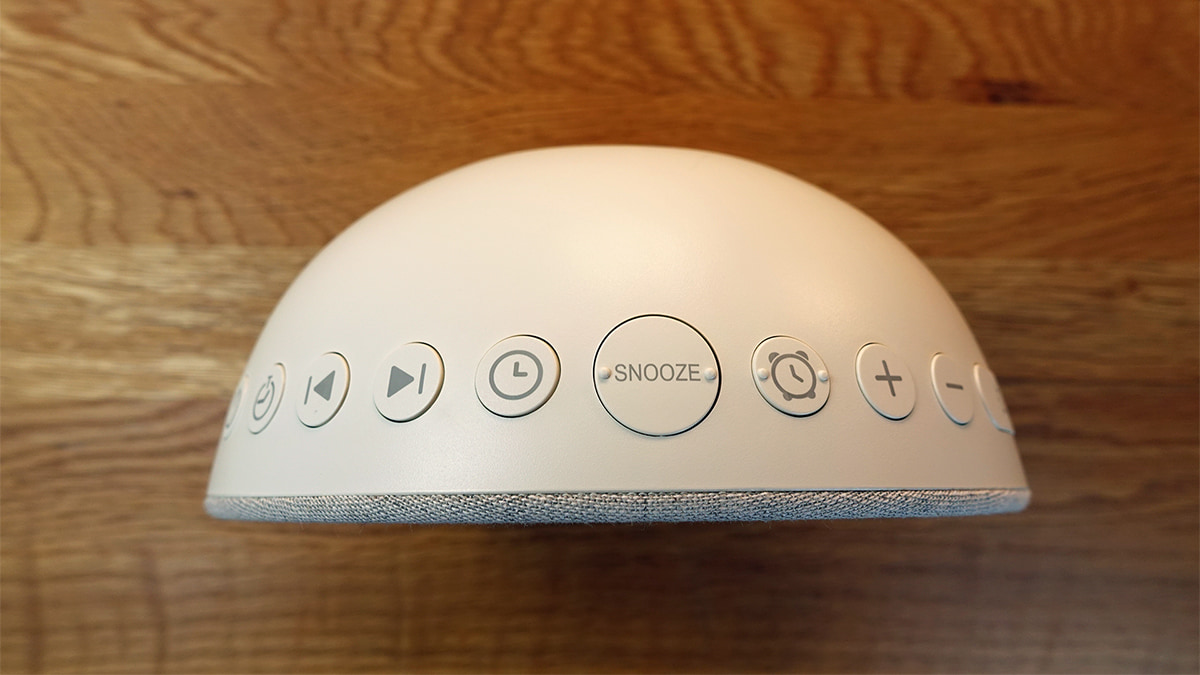
In the photo above, you can see the buttons of the Dreamegg Sunrise 1, all of which are on top. There’s also a slider on each side under the visible buttons to adjust the light or clock brightness.
It typically costs just under $100 in the US or £100 in the UK, for example, which makes it a mid-range sunrise alarm clock. If it only had the light and limited alarm options, I would feel that this is far too expensive. But the fact that it also works well as a white noise machine does go some way to justify the price.
5. Reacher Sunrise Alarm Clock
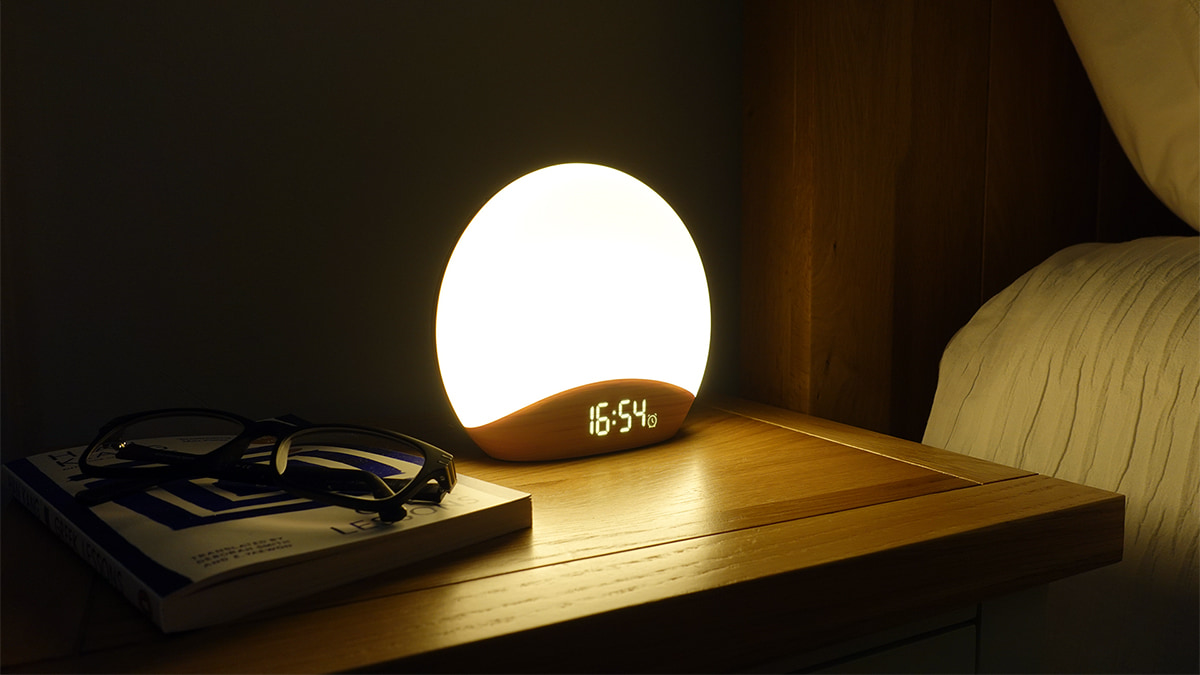
In the photo above, you can see the yellow glow of the Reacher Sunrise Alarm Clock.
Like the Lumie Sunrise Alarm, the Reacher is one of the better lower cost wake-up lights I’ve tried. However, better definitely doesn’t mean great, especially where the maximum brightness and the audio quality are concerned.
Starting with the design, I do like how compact it is, so it should fit on a small nightstand. It’s worth noting that the wood effect is just plastic, though, and the whole device looks and feels basic in daylight.
Like the Lumie Sunrise Alarm and Dreamegg Sunrise 1, there are several colors to choose from with the LEDs, such as red, blue, purple, and amber. All eight colors can be dimmed and used for the sunrise or night light.
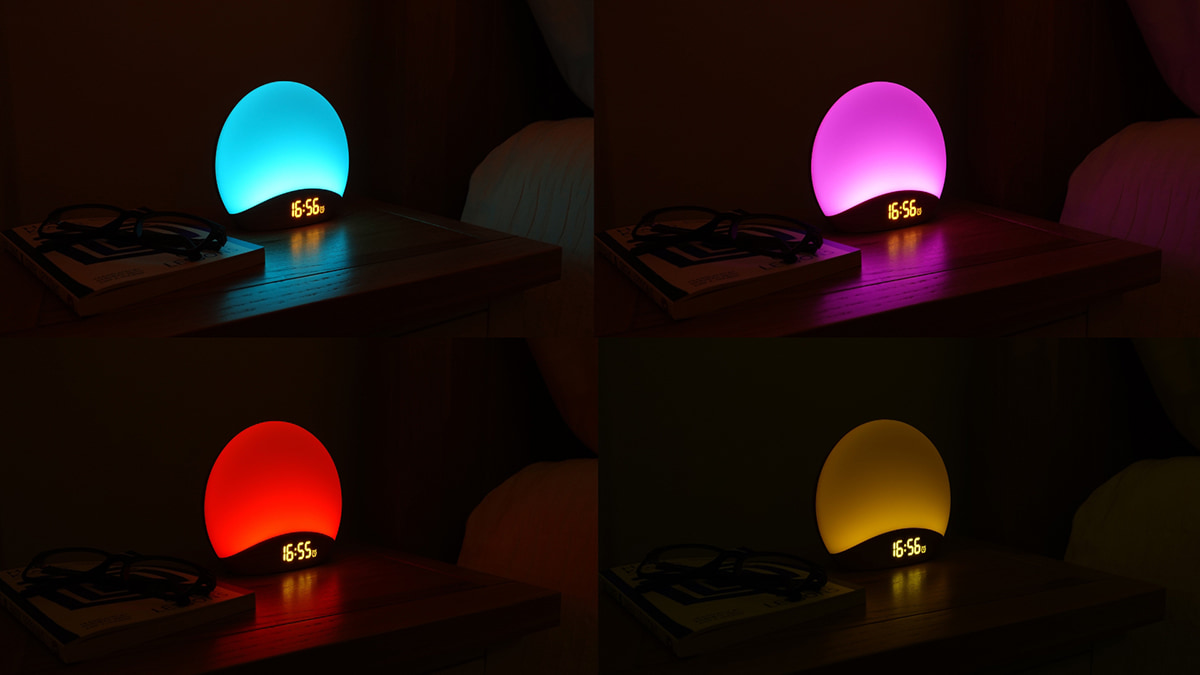
In the photo above, you can see four of the Reacher’s colours. The Dreamegg colours are very similar. The Lumie also has some similarities in terms of the strength and hue of the colours.
Here’s an example 20 minute sunrise filmed and sped up. There’s only one daily alarm to program, but it’s good that you can program the sunrise from 5 to 60 minutes. But once again, I missed the more realistic fade you get with the Philips or Bodyclock Shine 300 (you can watch the sunrise at 11:43 in the video).
The maximum brightness wasn’t nearly enough for me to use as a reading light, and I didn’t like how it made my book’s pages look jaundiced!
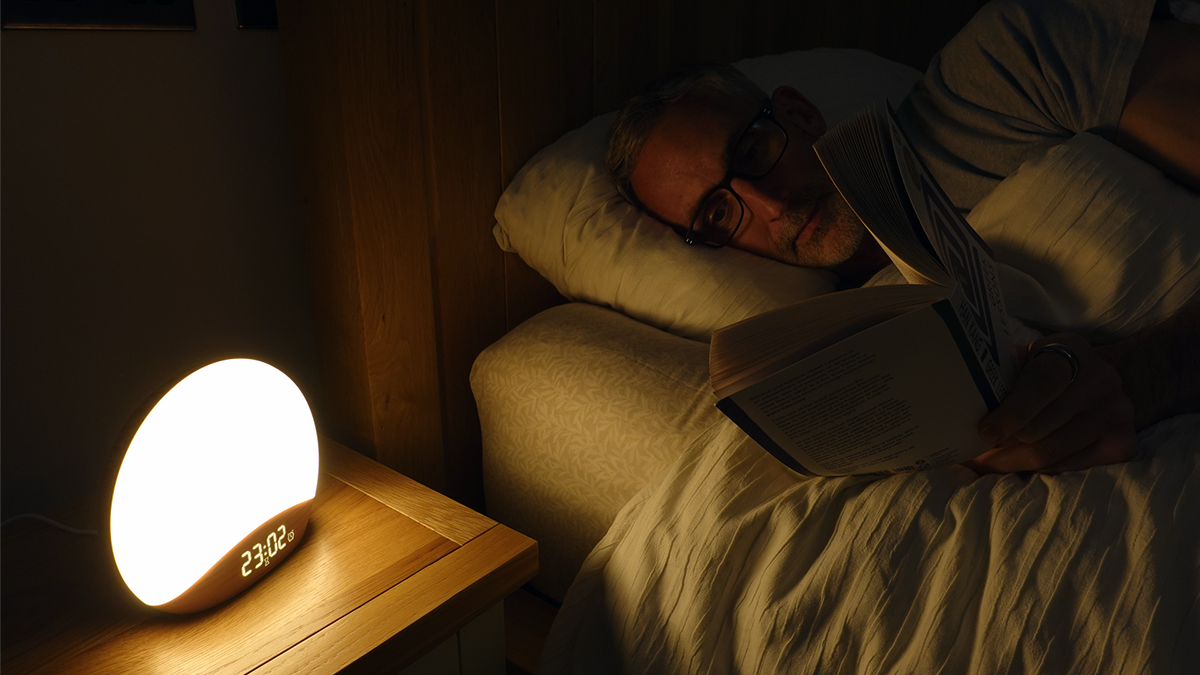
In the photo above, I’m trying my best to read with the yellow light of the Reacher. It’s a bit too dim for me, and I would have preferred a standard, brighter white light, which it doesn’t have.
Perhaps my biggest criticism is the speaker quality and sound choices. The speaker sounds very, very basic. And some sounds, like the birds, are unpleasantly piercing with the volume turned up.
I also don’t understand why there are only three possible alarm tones but 26 sounds that can be used at any time. Similar to the Dreamegg Sunrise 1 then, but with even less choice of alarm tones.
The Reacher only has a fading sunrise with an off sleep timer instead of a sunset effect. You can set the sleep timer from 5 to 180 minutes, which is good, but the light turns off very quickly at the end, just like the Dreamegg.
The buttons are quite easy to work out, but the user manual is the least clear of all five devices.
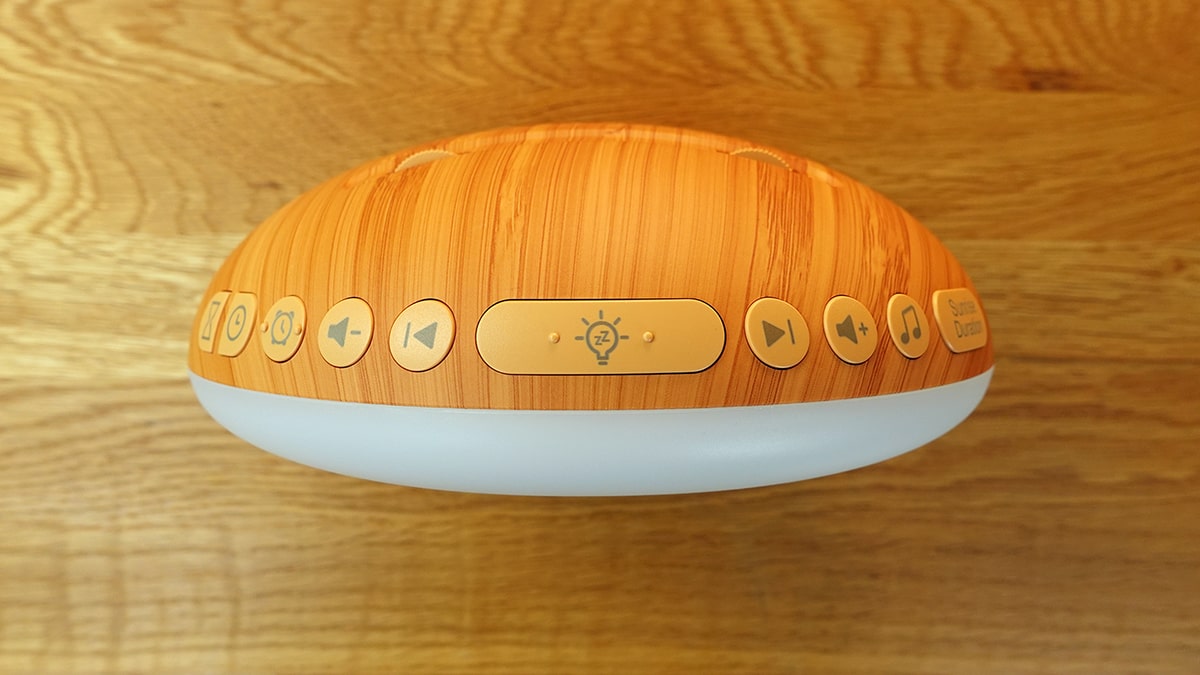
In the photo above, you can see the buttons of the Dreamegg Sunrise 1. All the buttons are on the top, but there are two sliders on the back that dim the main light and digital clock display.
It typically costs just under $50 in the US and £50 in the UK, which makes it more budget friendly than the higher-end sunrise alarm clocks.
If you’re on a budget and you’ve never used one of these before, then the Reacher will do the basics and does have some customization options. But if you’re expecting at least semi-decent audio or a realistic sunrise effect, you might be a bit disappointed.
Final thoughts
Hopefully this video (and article if you’re reading) will have demonstrated that the most important difference between sunrise alarm clocks is the quality of the sunrise and sunset effect, if they even have both.
My hope is that even if you’re watching this long after I’ve published it and one or two models are no longer available, it will give you an understanding of the things to look out for.
And it’s worth checking whether they have a realistic sunset effect and sunrise effect, or if it’s just a single color on a dimmer.
It’s also important to understand that the audio can really make or break a wake-up light. Even though the main focus is often on the light, the audio is important too.
Thanks for watching (or reading all the way to the end). Sleep well.

